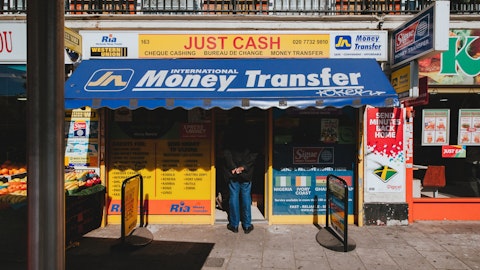Andras Bende: Yes, I would say for the €“ I would say, we’re planning relatively flat. So for the Intermex send amounts €“ well, I’ll just tell you where we ended for the fourth quarter. The Intermex average send was $434 million and La Nacional was right around $300 million. And we plan those in to be relatively flat. Now, it’s not relatively €“ it’s not flat sequentially, so it’s going to be flat when you compare quarter-to-quarter in the year. So we’re planning flat. The good thing about Mexico is Mexico’s actually growing a bit, so that could help us a little bit, but we’re not going to bank on that because in general, send amounts are €“ for most geographies are not increasing.
Alex Markgraff: Okay, thanks. I appreciate the detail there. And then just one more around the guidance. If you consider the midpoint of revenue and adjusted EBITDA and the margin implied there, I think it’s maybe 100 basis points of compression from 2022. Just kind of curious, I assume a lot of that’s related to La Nacional. Any sort of commentary in terms of organic margin expansion
Andras Bende: Yes. That’s
Alex Markgraff: Go ahead.
Andras Bende: I think you got it Alex. And I think that to €“ I know we’ll get the question in the call back, so it’s better to address it here. Within our guide for the year, we’ve got revenue for La Nacional and this is for four quarters of the U.S. business and three quarters of the European business, revenue about $85 million, EBITDA about $4 million, and then net income about $2.5 million. And you’ll see in our K, which we’ve released previously, we’re going to update the number in the K that’s going to say that we expect that business once fully integrated, which is going to take a little bit of time, about $80 million to $90 million in revenue, and then that same 9% and 11% EBITDA margins that we had mentioned in in previous K. So it’s going to take a little while for us to work it up there, but I think we’re optimistic and excited to get started.
Alex Markgraff: Okay. That’s great. Yes, that was my follow-up. So just to kind of clarify on that last point around some of the optimization that’s going on. It sounds like there is, within the guide you provided today some conservatism or some potential revisions to that as you kind of optimize the integration. Is that a fair summary?
Andras Bende: Yes, that’s fair.
Bob Lisy: Yes, I think €“ this is Bob. If the integration goes along faster, then that’ll certainly happen. I want to make clear what we have with La Nacional is exactly what we expected. We knew that it was a business that had a lot of upside potential in the U.S. and that it had to be right sized. It had a lot of €“ I think things that were being invested in that were probably in their minds great for the future, but were not necessarily things that we thought were consistent with how we saw the business in the future. So we’ve already started to cut some of those expenses and you’ll see some of that even affect the revenue year-over-year. So the revenue over time for the U.S. business could go down year-over-year, but the EBITDA will come way up.
And then when the European business is really the trump card, I mean, that’s a solid business that from everything we understand is making money today, small amount of money, but has an opportunity to grow many times and over. In the addition to that, the European business, which we haven’t talked much about, but I want to take this opportunity, provides us with a bigger opportunity in the online business than we have in the U.S. Our core strength in the U.S. is in countries where the digital online business is not as big a driving force as it might be with other countries. And the destinations from the U.S. are much more retail oriented. But when we get to Europe, there’s two factors. One, the countries that would be receiving the money are ones that are due more or greater percentage of their business digitally.
And then secondly, in Europe, there’s a lot less folks that might find themselves there undocumented. So they have a much greater percentage of folks that are paid on payroll and are paid with their bank accounts. And so they become candidates for the digital side. So we’re excited about that. There were many facets to the La Nacional acquisition and investment that we saw, and it’s kind of in stages. And what you see today is very much the unrefined piece of the business. There’s all these other things in terms of creating the right sizing and then the opportunities in Europe and online that will fall in with La Nacional over time.
Alex Markgraff: Great. Thank you both for all the commentary. Appreciate it.
Operator: Our next question will come from Chris Young with Credit Suisse. You may now go ahead.
Chris Young: Hi. Thanks for taking our question and also appreciate the great color on La Nacional including the 2023 contribution and also the margin profile, the opportunities there both in Latin America and in Europe. I just wanted to dig in a little more as the €“ right now the La Nacional’s margins are lower and you mentioned they’re optimizing the agent locations, but just wanted to understand structurally are the margins lower because of some of the legacy agent commission contracts or for some of the reasons? And then if you could probably just break down the contribution from the Latin America versus the Europe from La Nacional and then at what level of the revenue which is being, will bring the business to Latin America to the right margin profile that you desire?
Bob Lisy: Okay. So let me, hopefully I’ll remember every one of those questions. That was pretty extensive. But on the first piece, you asked about margins. So La Nacional, the U.S. piece is driven by their business to Dominican Republic, which is a country where most of the money is sent in U.S. dollars. So there doesn’t €“ there is not any profit made and the exchange rate are very little. Some of it goes in local currency. And so as a market throughout the U.S. outbound, the Dominican market is not as profitable as Mexico for sure or even Guatemala. So you’re going to see smaller margins there. The other piece is until it’s right sized is the business still has all of the overhead that any business would have with a much lower revenue.
And so that’s part of what we’re doing in terms of that sort of SG&A cost, right. And making it right sized and making sure that it makes. Go ahead. Were you saying something? And in making sure that it’s right size. So that has a lot to do with it. What was your €“ help me with the other questions. What was the next question?





